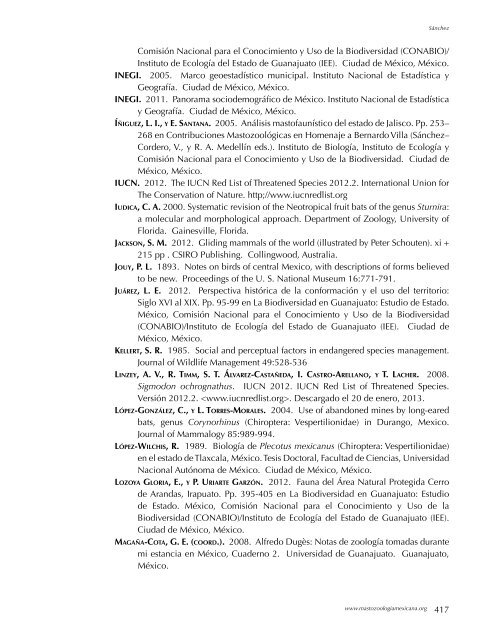therya-5_2
therya-5_2
therya-5_2
You also want an ePaper? Increase the reach of your titles
YUMPU automatically turns print PDFs into web optimized ePapers that Google loves.
Sánchez<br />
Comisión Nacional para el Conocimiento y Uso de la Biodiversidad (CONABIO)/<br />
Instituto de Ecología del Estado de Guanajuato (IEE). Ciudad de México, México.<br />
INEGI. 2005. Marco geoestadístico municipal. Instituto Nacional de Estadística y<br />
Geografía. Ciudad de México, México.<br />
INEGI. 2011. Panorama sociodemográfico de México. Instituto Nacional de Estadística<br />
y Geografía. Ciudad de México, México.<br />
Íñiguez, L. I., y E. Santana. 2005. Análisis mastofaunístico del estado de Jalisco. Pp. 253–<br />
268 en Contribuciones Mastozoológicas en Homenaje a Bernardo Villa (Sánchez–<br />
Cordero, V., y R. A. Medellín eds.). Instituto de Biología, Instituto de Ecología y<br />
Comisión Nacional para el Conocimiento y Uso de la Biodiversidad. Ciudad de<br />
México, México.<br />
IUCN. 2012. The IUCN Red List of Threatened Species 2012.2. International Union for<br />
The Conservation of Nature. http;//www.iucnredlist.org<br />
Iudica, C. A. 2000. Systematic revision of the Neotropical fruit bats of the genus Sturnira:<br />
a molecular and morphological approach. Department of Zoology, University of<br />
Florida. Gainesville, Florida.<br />
Jackson, S. M. 2012. Gliding mammals of the world (illustrated by Peter Schouten). xi +<br />
215 pp . CSIRO Publishing. Collingwood, Australia.<br />
Jouy, P. L. 1893. Notes on birds of central Mexico, with descriptions of forms believed<br />
to be new. Proceedings of the U. S. National Museum 16:771-791.<br />
Juárez, L. E. 2012. Perspectiva histórica de la conformación y el uso del territorio:<br />
Siglo XVI al XIX. Pp. 95-99 en La Biodiversidad en Guanajuato: Estudio de Estado.<br />
México, Comisión Nacional para el Conocimiento y Uso de la Biodiversidad<br />
(CONABIO)/Instituto de Ecología del Estado de Guanajuato (IEE). Ciudad de<br />
México, México.<br />
Kellert, S. R. 1985. Social and perceptual factors in endangered species management.<br />
Journal of Wildlife Management 49:528-536<br />
Linzey, A. V., R. Timm, S. T. Álvarez-Castañeda, I. Castro-Arellano, y T. Lacher. 2008.<br />
Sigmodon ochrognathus. IUCN 2012. IUCN Red List of Threatened Species.<br />
Versión 2012.2. . Descargado el 20 de enero, 2013.<br />
López-González, C., y L. Torres-Morales. 2004. Use of abandoned mines by long-eared<br />
bats, genus Corynorhinus (Chiroptera: Vespertilionidae) in Durango, Mexico.<br />
Journal of Mammalogy 85:989-994.<br />
López-Wilchis, R. 1989. Biología de Plecotus mexicanus (Chiroptera: Vespertilionidae)<br />
en el estado de Tlaxcala, México. Tesis Doctoral, Facultad de Ciencias, Universidad<br />
Nacional Autónoma de México. Ciudad de México, México.<br />
Lozoya Gloria, E., y P. Uriarte Garzón. 2012. Fauna del Área Natural Protegida Cerro<br />
de Arandas, Irapuato. Pp. 395-405 en La Biodiversidad en Guanajuato: Estudio<br />
de Estado. México, Comisión Nacional para el Conocimiento y Uso de la<br />
Biodiversidad (CONABIO)/Instituto de Ecología del Estado de Guanajuato (IEE).<br />
Ciudad de México, México.<br />
Magaña-Cota, G. E. (coord.). 2008. Alfredo Dugès: Notas de zoología tomadas durante<br />
mi estancia en México, Cuaderno 2. Universidad de Guanajuato. Guanajuato,<br />
México.<br />
www.mastozoologiamexicana.org<br />
417



